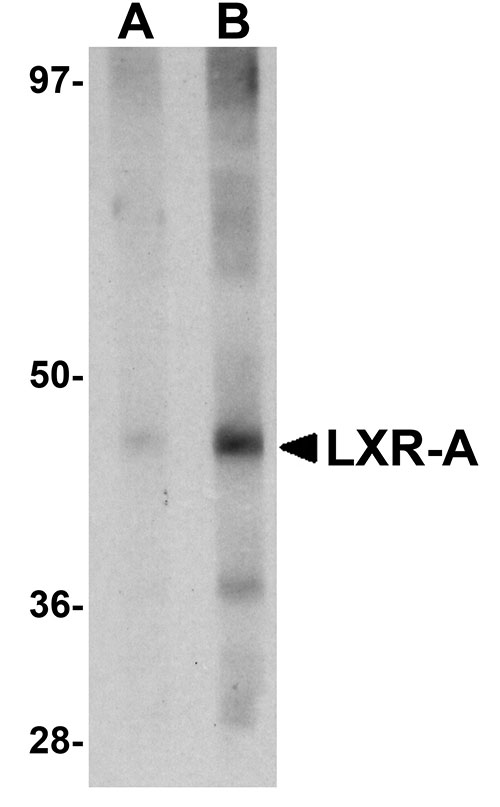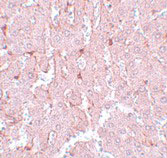LXR-A Antibody
- 产品详情
- 实验流程
- 背景知识
Application
| WB, IF, E, IHC-P |
|---|---|
| Primary Accession | Q13133 |
| Other Accession | NP_005684, 194294517 |
| Reactivity | Human, Mouse, Rat |
| Host | Rabbit |
| Clonality | Polyclonal |
| Isotype | IgG |
| Calculated MW | 50396 Da |
| Concentration (mg/ml) | 1 mg/mL |
| Conjugate | Unconjugated |
| Application Notes | LXR-A antibody can be used for detection of LXR-A by Western blot at 1 - 2 µg/mL. Antibody can also be used for immunohistochemistry starting at 5 µg/mL. For immunofluorescence start at 20 µg/mL. |
| Gene ID | 10062 |
|---|---|
| Other Names | Oxysterols receptor LXR-alpha, Liver X receptor alpha, Nuclear receptor subfamily 1 group H member 3, NR1H3, LXRA |
| Target/Specificity | NR1H3; |
| Reconstitution & Storage | LXR-A antibody can be stored at 4℃ for three months and -20℃, stable for up to one year. As with all antibodies care should be taken to avoid repeated freeze thaw cycles. Antibodies should not be exposed to prolonged high temperatures. |
| Precautions | LXR-A Antibody is for research use only and not for use in diagnostic or therapeutic procedures. |
| Name | NR1H3 |
|---|---|
| Synonyms | LXRA |
| Function | Nuclear receptor that exhibits a ligand-dependent transcriptional activation activity (PubMed:19481530, PubMed:25661920, PubMed:37478846). Interaction with retinoic acid receptor (RXR) shifts RXR from its role as a silent DNA-binding partner to an active ligand- binding subunit in mediating retinoid responses through target genes defined by LXRES (PubMed:37478846). LXRES are DR4-type response elements characterized by direct repeats of two similar hexanuclotide half-sites spaced by four nucleotides (By similarity). Plays an important role in the regulation of cholesterol homeostasis, regulating cholesterol uptake through MYLIP-dependent ubiquitination of LDLR, VLDLR and LRP8 (PubMed:19481530). Interplays functionally with RORA for the regulation of genes involved in liver metabolism (By similarity). Induces LPCAT3-dependent phospholipid remodeling in endoplasmic reticulum (ER) membranes of hepatocytes, driving SREBF1 processing and lipogenesis (By similarity). Via LPCAT3, triggers the incorporation of arachidonate into phosphatidylcholines of ER membranes, increasing membrane dynamics and enabling triacylglycerols transfer to nascent very low-density lipoprotein (VLDL) particles. Via LPCAT3 also counteracts lipid-induced ER stress response and inflammation, likely by modulating SRC kinase membrane compartmentalization and limiting the synthesis of lipid inflammatory mediators (By similarity). |
| Cellular Location | Nucleus {ECO:0000255|PROSITE-ProRule:PRU00407, ECO:0000269|PubMed:25661920}. Cytoplasm {ECO:0000250|UniProtKB:Q9Z0Y9} |
| Tissue Location | Visceral organs specific expression. Strong expression was found in liver, kidney and intestine followed by spleen and to a lesser extent the adrenals |
For Research Use Only. Not For Use In Diagnostic Procedures.
Provided below are standard protocols that you may find useful for product applications.
BACKGROUND
LXR-A Antibody: LXR-A belongs to the Liver X Receptor family that encodes highly homologous transcription factors. Like the highly homologous LXR-B, LXR-A forms heterodimers with the retinoic acid receptor RXRalpha, function as sensors for cellular oxysterols which when activated, increase the expression of genes that control sterol and fatty acid metabolism and homeostasis. Recent experiments have indicated that the LXRs can also modulate both innate and adaptive immune responses. Human and mouse tumors produce LXR ligands that inhibit CCR7 expression on maturing dendritic cells (DCs), thereby allowing tumor immunoescape. In mouse models, it was shown that ablating LXR-A signaling led to an immune-mediated strong inhibition of tumor growth, suggesting that manipulation of this pathway may be a viable anti-cancer approach.
REFERENCES
Willy PJ, Umesono K, Ong ES, et al. LXR, a nuclear receptor that defines a distinct retinoid response pathway. Genes Dev.1995; 9:1033-45.
Edwards PA, Kennedy MA, and Mak PA. LXRs; Oxysterol-activated nuclear receptors that regulate genes controlling lipid homeostasis. Vasc. Pharmacol.2002; 38:249-56.
Bensinger SJ and Tontonoz P. Integration of metabolism and inflammation by lipid-activated nuclear receptors. Nature2008; 454:470-7.
Villablanca EJ, Raccosta L, Zhou D, et al. Tumor-mediated liver X receptor-a activation inhibits CC chemokine reeptor-7 expression on dendritic cells and dampens antitumor responses. Nature Med.2010; 16:98-106.
终于等到您。ABCEPTA(百远生物)抗体产品。
点击下方“我要评价 ”按钮提交您的反馈信息,您的反馈和评价是我们最宝贵的财富之一,
我们将在1-3个工作日内处理您的反馈信息。
如有疑问,联系:0512-88856768 tech-china@abcepta.com.























 癌症的基本特征包括细胞增殖、血管生成、迁移、凋亡逃避机制和细胞永生等。找到癌症发生过程中这些通路的关键标记物和对应的抗体用于检测至关重要。
癌症的基本特征包括细胞增殖、血管生成、迁移、凋亡逃避机制和细胞永生等。找到癌症发生过程中这些通路的关键标记物和对应的抗体用于检测至关重要。 为您推荐一个泛素化位点预测神器——泛素化分析工具,可以为您的蛋白的泛素化位点作出预测和评分。
为您推荐一个泛素化位点预测神器——泛素化分析工具,可以为您的蛋白的泛素化位点作出预测和评分。 细胞自噬受体图形绘图工具为你的蛋白的细胞受体结合位点作出预测和评分,识别结合到自噬通路中的蛋白是非常重要的,便于让我们理解自噬在正常生理、病理过程中的作用,如发育、细胞分化、神经退化性疾病、压力条件下、感染和癌症。
细胞自噬受体图形绘图工具为你的蛋白的细胞受体结合位点作出预测和评分,识别结合到自噬通路中的蛋白是非常重要的,便于让我们理解自噬在正常生理、病理过程中的作用,如发育、细胞分化、神经退化性疾病、压力条件下、感染和癌症。








